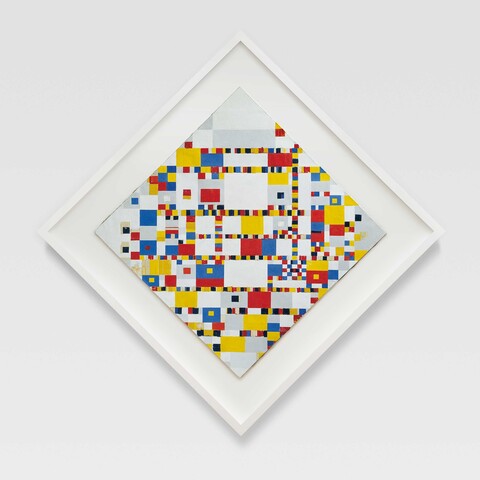
Mondrian & De Stijl
Kunstmuseum Den Haag has the largest collection of Mondrians in the world. Visit the permanent exhibition Mondrian...
Kunstmuseum Den Haag has a treasure chamber of over 160.000 pieces of art. Here we work on making the highlights from this collection available online.
In 2017 it will be exactly 100 years since the launch of the Dutch art and design movement known as ‘De Stijl’. The Netherlands is set to mark the centenary with a year-long programme of events under the title Mondrian to Dutch Design. 100 years of De Stijl. As home both of the world’s greatest Mondrian collection and of one of its major De Stijl collections, the Gemeentemuseum will be at the heart of the celebrations in 2017. No fewer than four separate exhibitions will be held at the museum to pay appropriate tribute to the group’s revolutionary achievements. The event kicks off on 11 February with an exhibition about the genesis of a new kind of art that has forever changed the world we live in.
De Stijl’s iconic red, yellow and blue palette is still in vogue. You see it in today’s fashion and magazine design, on packaging, in advertisement and in video clips. But who actually invented the movement’s distinctive signature style? This spring, the Gemeentemuseum Den Haag unravels the history of De Stijl’s radical new art. Key to it was the friendship and reciprocal influence between the movement’s two foremost painters: Piet Mondrian and Bart van der Leck.
Who invented De Stijl’s iconic red, yellow and blue palette?
Piet Mondrian and Bart van der Leck met during the First World War in the Dutch village of Laren (then an artists’ colony). By then, Mondrian had lived in Paris for several years, but when the First World War broke out while he was visiting family in the Netherlands he was unable to return to the French capital for the time being. Bart van der Leck did much of his work in the Netherlands, some of it in The Hague.
Van der Leck and Mondrian shared a strong conviction that the modern world needed a new kind of art. Van der Leck’s ideas were based on his experience as a stained glass artist and his admiration of the formal simplification found in Egyptian art. Mondrian was very taken with Van der Leck’s use of colours. Van der Leck was impressed by Mondrian’s search for abstraction. Following Mondrian’s example, Van der Leck began calling his paintings ‘compositions’ and found the courage to abandon his figurative approach.
The exhibition unravels the history of a friendship that produced the fundamental philosophy of De Stijl.
Mondrian discovered the key to abstraction in the Cubism he encountered in Paris. During his first two years there, he concentrated mainly on reworking earlier figurative paintings in a Cubist style. Van der Leck employed a different approach: a method he called ‘doorbeelding’ (an untranslatable term approximating to ‘decomposition’). Starting with a figurative sketch – for example, of a person or an animal – he gradually reduced it to geometrical shapes. But, working independently of each other, both arrived at a method of producing abstract art.
This will be the first exhibition ever to examine the exact nature and lasting influence of the relationship between Mondrian and Van der Leck. Referring to paintings, photographs, letters and other archival materials , the presentation unravels the story of this friendship. The exhibition will also feature items on loan from institutions including MoMA and the Solomon R. Guggenheim Museum in New York.